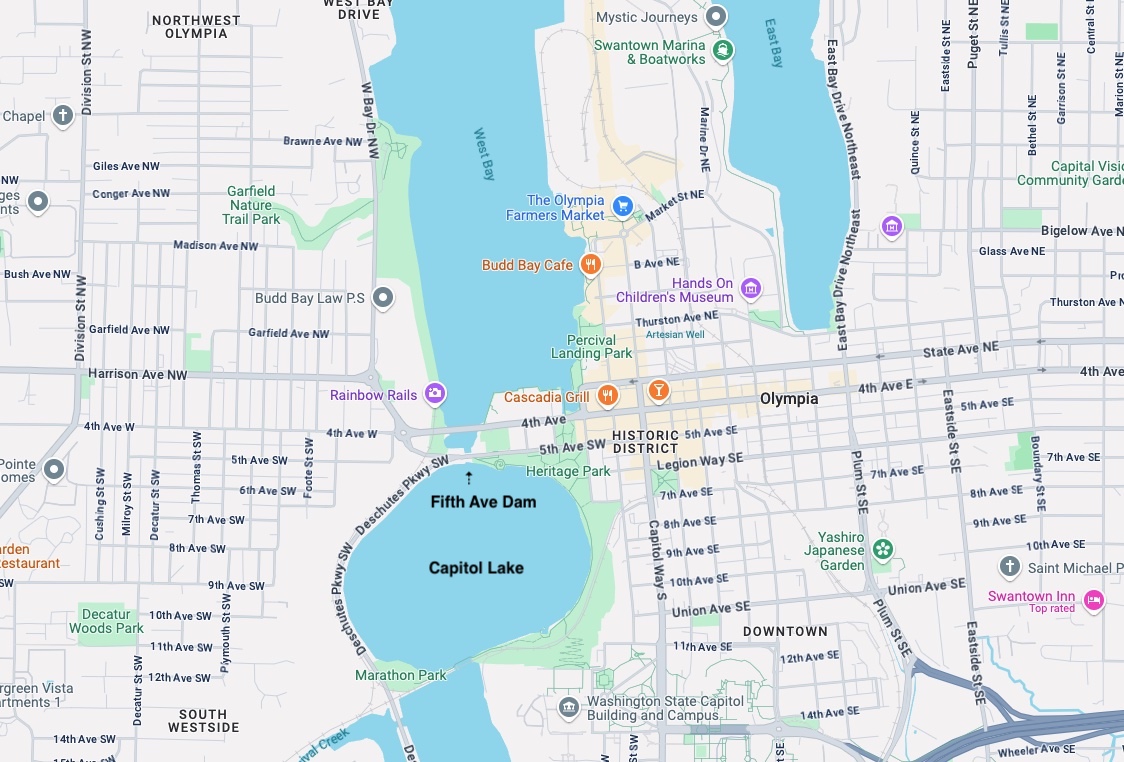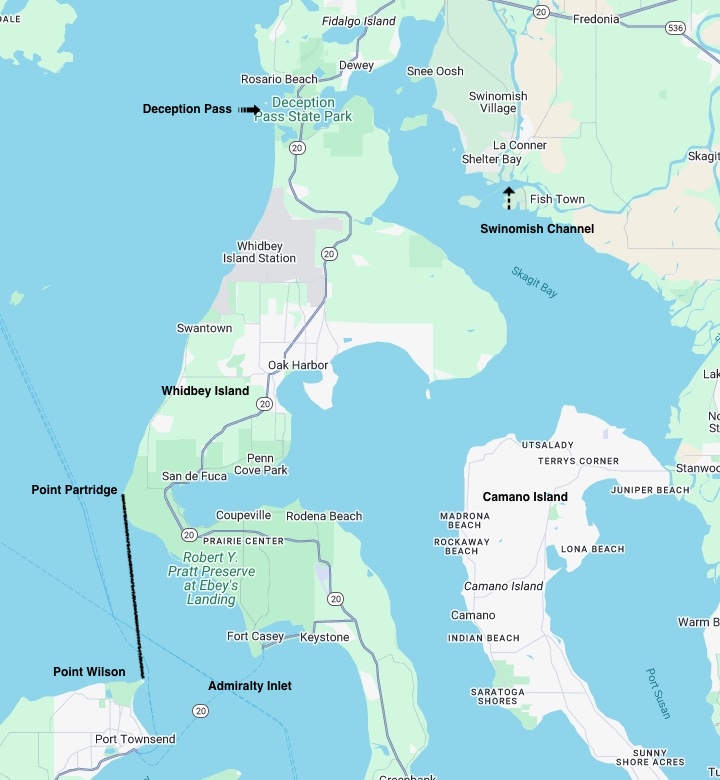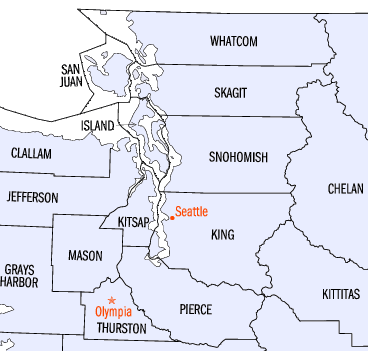What Counts as Puget Sound?


If you’ve ever wondered “Is this part of Puget Sound?” — you’re not alone. The term “Puget Sound” shows up everywhere: in real estate listings, weather forecasts, ferry schedules, and regional news. But what actually counts as Puget Sound? Is it just the water? The cities along its shores? The surrounding counties?
Let’s break it down — from the water itself to the broader region locals and geographers refer to when they say "Puget Sound," "the Puget Sound area" or just "the Sound." (Just don't call it "the Puget Sound").
This section gets a little technical, but perhaps the easiest way to remember the boundaries of Puget Sound is that it's the waters east of Whidbey Island and south of Port Townsend.
The northern boundaries: Looking at the map at right, if you go east through Deception Pass, all the water southward is part of Puget Sound. In the lower left section, everything southward from Admiralty Inlet between Point Wilson (Port Townsend) and Point Partridge (Whidbey) is also Puget Sound. In addition to Admiralty Inlet and Deception Pass, one other waterway leads into Puget Sound: the Swinomish Channel in the upper right portion of the map which leads in from Padilla Bay.
The southern boundaries: Wherever the saltwater stops is a southern boundary of Puget Sound. Looking at the map below, you can see the southernmost boundary of Puget Sound, which is West Bay. West Bay and East Bay lead directly to Budd Inlet just to the north of the map edge, which is considered the southern boundary of Puget Sound.
Of note: the Fifth Avenue Dam, which separates West Bay from Capitol Lake will soon be removed to restore the traditional estuary.
The National Oceanic and Atmospheric Administration's definition: NOAA describes Puget Sound in terms of "basins" or regions (numbers corresponding to the map at right):



Locals often use “Puget Sound” more loosely — to refer to a broad geographic region that includes cities, suburbs, islands, and rural areas surrounding the water. This “Puget Sound region” is home to over four million people and typically includes parts of these counties:
On the east from north to south:
San Juan County and Whatcom County (Bellingham and Blaine) may also be included, but they are north of the Swinomish Channel.

Many of the islands within and around the Sound are part of both the water body and the region. Key islands include:
Camano, Whidbey and Bainbridge Islands are all connected to the mainland by bridge. The Maury-Vashon tombolo connection was built more than a century ago. Of these, only Camano does not have ferry service, but all of these islands are popular residential areas offering quiet lifestyles with city access.
The San Juan Islands, Fidalgo Island, Guemes Island and other northern islands are part of the Salish Sea and not generally considered to be part of Puget Sound.
Yes — Olympia sits at the southernmost tip of Puget Sound, where Budd Inlet forms the city's working waterfront. While it's less talked about than Seattle or Tacoma, it is fully within both the hydrological and regional definition of Puget Sound. And, of course, it's the capital of Washington and has the Legislative Building, a beautiful example of Neoclassical architecture with a dome and classical columns.
There’s no official list, but commonly recognized Puget Sound cities include:
Even many inland suburbs (like Kirkland, Lynnwood and Redmond) are considered part of the greater Puget Sound metro area.
The Salish Sea is the larger body of water that includes Puget Sound, the Strait of Juan de Fuca, and the Strait of Georgia (up into British Columbia). Puget Sound is just the southern portion of this greater inland sea system.
So: All of Puget Sound is part of the Salish Sea, but not all of the Salish Sea is Puget Sound.
If you're relocating or just want to understand the communities around the Sound, check out our Puget Sound Neighborhoods guide. It includes breakdowns of city neighborhoods, islands, ferry access points, and local housing markets — all in one place.
So what counts as Puget Sound? It depends on who you ask — a scientist, a local, or a real estate agent might all give you slightly different answers. But if you're talking about the heart of western Washington, the natural beauty, and the communities that hug the coast, you're probably talking about Puget Sound.
Whether you're new to the area or a lifelong resident, there's always more to discover in this incredibly diverse region.
Share My QR |
|
We firmly believe that the internet should be available and accessible to anyone, and are committed to providing a website that is accessible to the widest possible audience, regardless of circumstance and ability.
To fulfill this, we aim to adhere as strictly as possible to the World Wide Web Consortium’s (W3C) Web Content Accessibility Guidelines 2.1 (WCAG 2.1) at the AA level. These guidelines explain how to make web content accessible to people with a wide array of disabilities. Complying with those guidelines helps us ensure that the website is accessible to all people: blind people, people with motor impairments, visual impairment, cognitive disabilities, and more.
This website utilizes various technologies that are meant to make it as accessible as possible at all times. We utilize an accessibility interface that allows persons with specific disabilities to adjust the website’s UI (user interface) and design it to their personal needs.
Additionally, the website utilizes an AI-based application that runs in the background and optimizes its accessibility level constantly. This application remediates the website’s HTML, adapts Its functionality and behavior for screen-readers used by the blind users, and for keyboard functions used by individuals with motor impairments.
If you’ve found a malfunction or have ideas for improvement, we’ll be happy to hear from you. You can reach out to the website’s operators by using the following email [email protected]
Our website implements the ARIA attributes (Accessible Rich Internet Applications) technique, alongside various different behavioral changes, to ensure blind users visiting with screen-readers are able to read, comprehend, and enjoy the website’s functions. As soon as a user with a screen-reader enters your site, they immediately receive a prompt to enter the Screen-Reader Profile so they can browse and operate your site effectively. Here’s how our website covers some of the most important screen-reader requirements, alongside console screenshots of code examples:
Screen-reader optimization: we run a background process that learns the website’s components from top to bottom, to ensure ongoing compliance even when updating the website. In this process, we provide screen-readers with meaningful data using the ARIA set of attributes. For example, we provide accurate form labels; descriptions for actionable icons (social media icons, search icons, cart icons, etc.); validation guidance for form inputs; element roles such as buttons, menus, modal dialogues (popups), and others. Additionally, the background process scans all of the website’s images and provides an accurate and meaningful image-object-recognition-based description as an ALT (alternate text) tag for images that are not described. It will also extract texts that are embedded within the image, using an OCR (optical character recognition) technology. To turn on screen-reader adjustments at any time, users need only to press the Alt+1 keyboard combination. Screen-reader users also get automatic announcements to turn the Screen-reader mode on as soon as they enter the website.
These adjustments are compatible with all popular screen readers, including JAWS and NVDA.
Keyboard navigation optimization: The background process also adjusts the website’s HTML, and adds various behaviors using JavaScript code to make the website operable by the keyboard. This includes the ability to navigate the website using the Tab and Shift+Tab keys, operate dropdowns with the arrow keys, close them with Esc, trigger buttons and links using the Enter key, navigate between radio and checkbox elements using the arrow keys, and fill them in with the Spacebar or Enter key.Additionally, keyboard users will find quick-navigation and content-skip menus, available at any time by clicking Alt+1, or as the first elements of the site while navigating with the keyboard. The background process also handles triggered popups by moving the keyboard focus towards them as soon as they appear, and not allow the focus drift outside of it.
Users can also use shortcuts such as “M” (menus), “H” (headings), “F” (forms), “B” (buttons), and “G” (graphics) to jump to specific elements.
We aim to support the widest array of browsers and assistive technologies as possible, so our users can choose the best fitting tools for them, with as few limitations as possible. Therefore, we have worked very hard to be able to support all major systems that comprise over 95% of the user market share including Google Chrome, Mozilla Firefox, Apple Safari, Opera and Microsoft Edge, JAWS and NVDA (screen readers), both for Windows and for MAC users.
Despite our very best efforts to allow anybody to adjust the website to their needs, there may still be pages or sections that are not fully accessible, are in the process of becoming accessible, or are lacking an adequate technological solution to make them accessible. Still, we are continually improving our accessibility, adding, updating and improving its options and features, and developing and adopting new technologies. All this is meant to reach the optimal level of accessibility, following technological advancements. For any assistance, please reach out to [email protected]